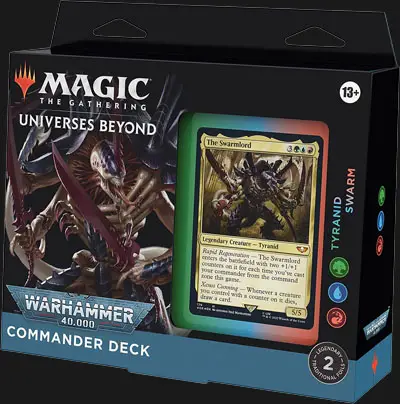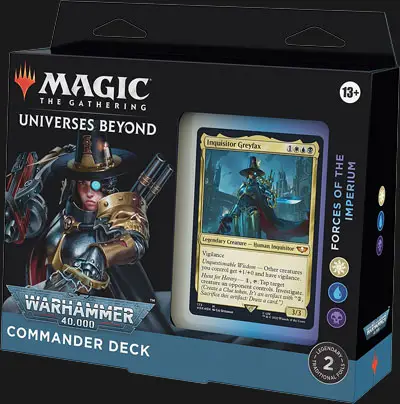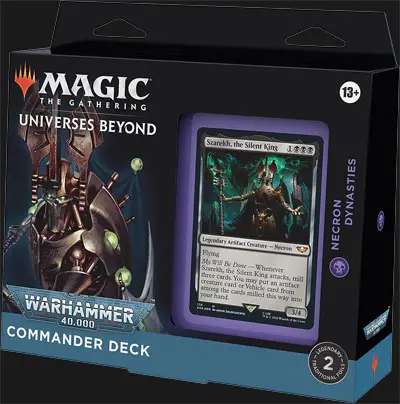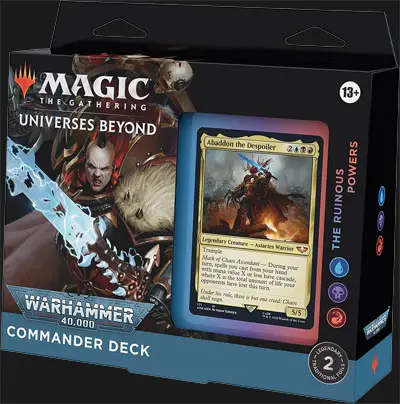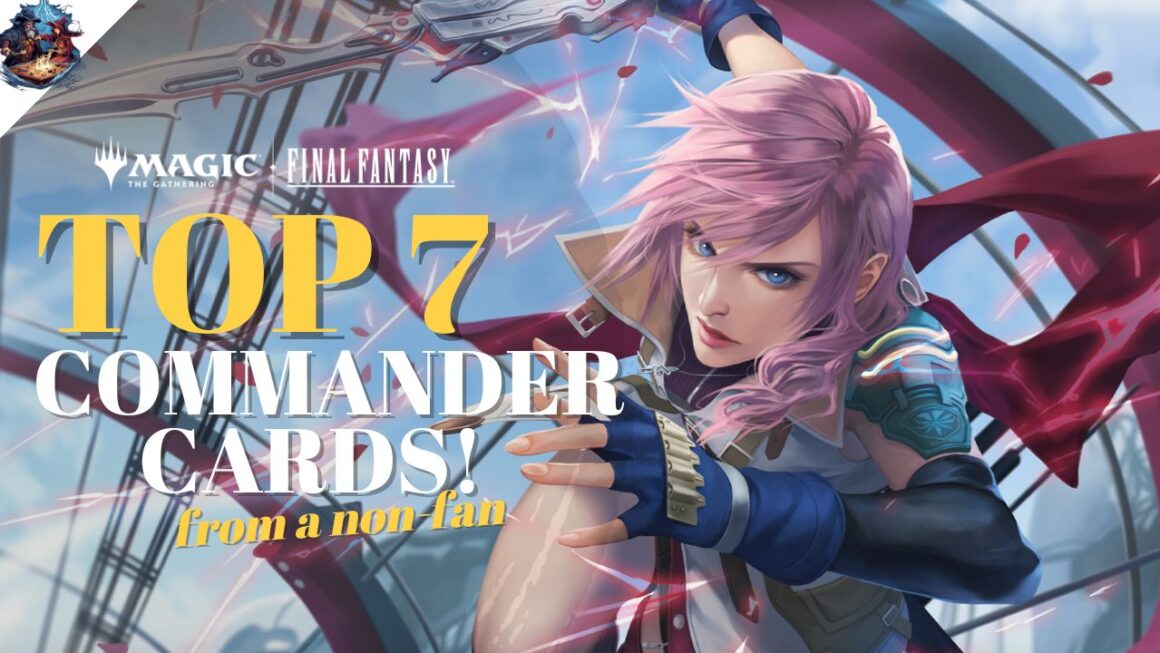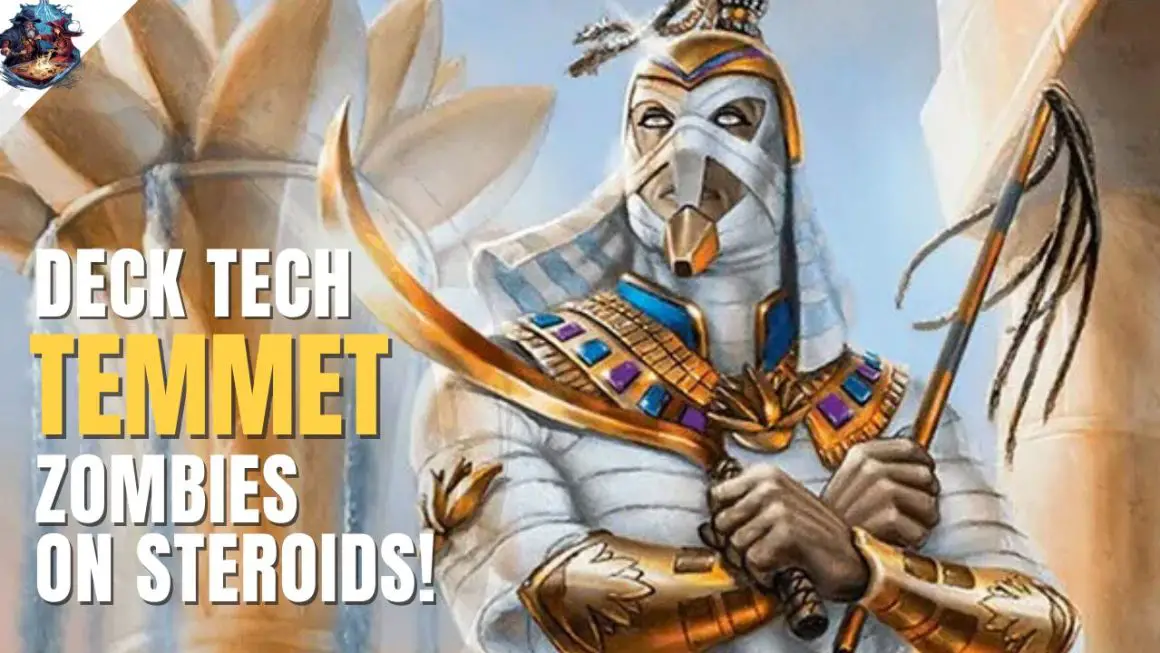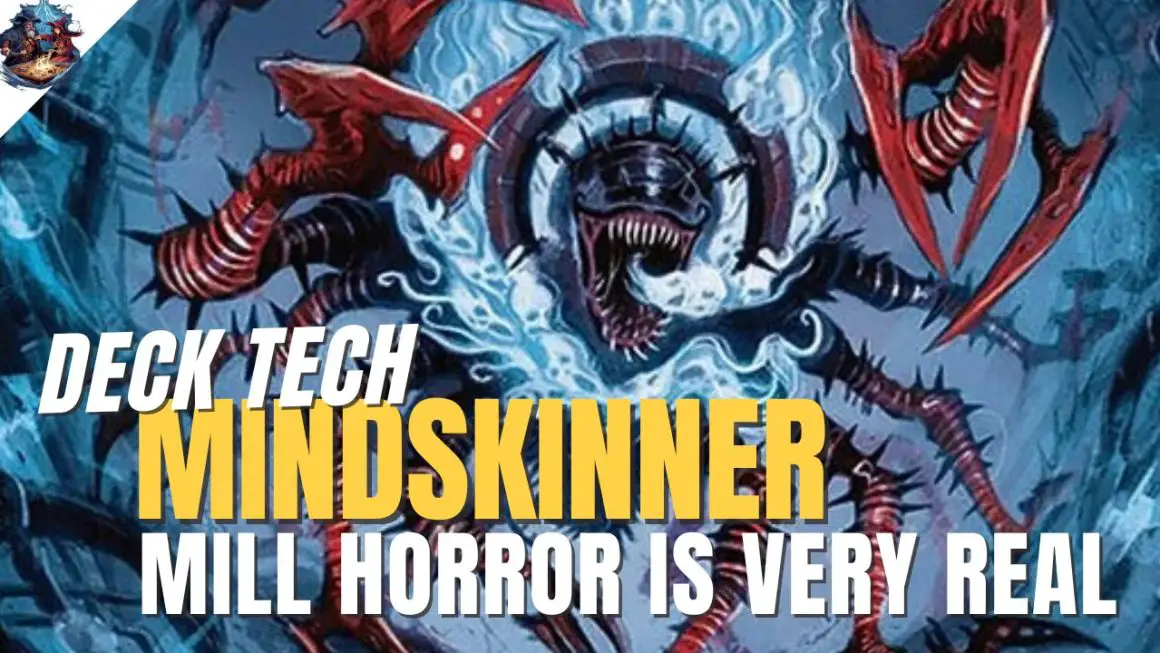While both Warhammer and Magic: the Gathering players have managed to hold off going at each other’s throats for 6 months, the Universes Beyond crossover Commander decks are finally here! The war has been sounded, and before you go off fighting within your own playgroups, it would be wise to find out which deck offers the highest power level, or is more friendly for a new player.
While you may have already checked out the full card lists of all 4 decks, there isn’t a comparison review quite like the one below.
Before we get started, a quick recap on our rating system:
Power Level: How likely can the deck hold its own and win against the other recent precon decks?
Value: How good is the deck in terms of financial value of reprints, as well as future potential gain?
Upgradability: How easily can this deck be upgraded and optimised with a small budget? A high potential for upgrades will lead to better scores.
Beginner Friendliness: How easily can a beginner pick up and learn the mechanics of the deck?
As always, do drop us an email if you have any suggestions or feedback on the deck ratings.
Forces of the Imperium Warhammer 40K Commander
Overview
Forces of the Imperium follows the human armies of Astartes, creating loads of value the more you have on the board. Their Commander, Inquisitor Greyfax even gives everyone +1/+0 and Vigilance for both attack and defense duties! The Esper (blue, white, black) colour identity also means lots of control pieces that will help you level the enemies!
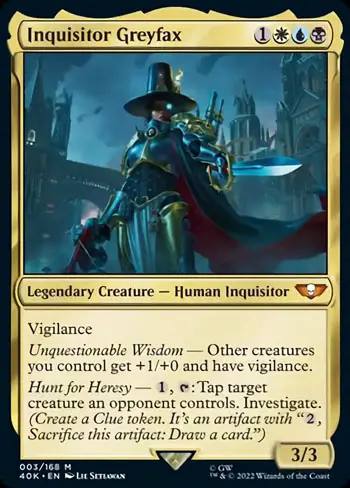
Power Level
Force of the Imperium boasts good synergy and payoffs when you have a sizeable board state on the Battlefield. Commissar Severina Raine is especially good at draining massive life from each opponent, and she even has the ability to help you draw cards. Assault Intercessor has the opposite effect, providing a disincentive for opponents to block your attackers, since for each of their Creature that dies, they lose 2 life. Likewise, Sanguinary Priest provides some insurance against a board wipe spell. If anyone wants to kill off your 10 Creatures, they would need to be prepared to take 10 damage.
Like most preconstructed decks, the removal options are not fantastic, but there is a copy of Swords to Plowshares and a still useful but less optimal Utter End. We wouldn’t rely on Exterminus or Hour of Reckoning for efficiency as there are better options available.
The deck’s strength comes from its Creatures, so once you have multiple of them on the board, the attacking force is quite menacing, with a few even having First Strike. In the late game, the Squad mechanic lets you makes copies of Creatures for additional buffs. Buff effects like from The Flesh is Weak or For the Emperor! can easily double the strength of your troops and take out 1 opponent before they know what hit them.
Value
With some potentially powerful cards in this preconstructed deck, Force of the Imperium sits pretty well in the value department, with each regular deck likely costing between US$50-60. Because these Warhammer 40K decks are also more expensive than regular Commander preconstructed ones, the value category will also be lower across the board.
The Golden Throne has some long term potential for its ability to repeatedly add 3 Mana of any colour, for a cost of 4. You do have a Sacrifice a Creature to do that, but in a token deck, this shouldn’t be an issue.
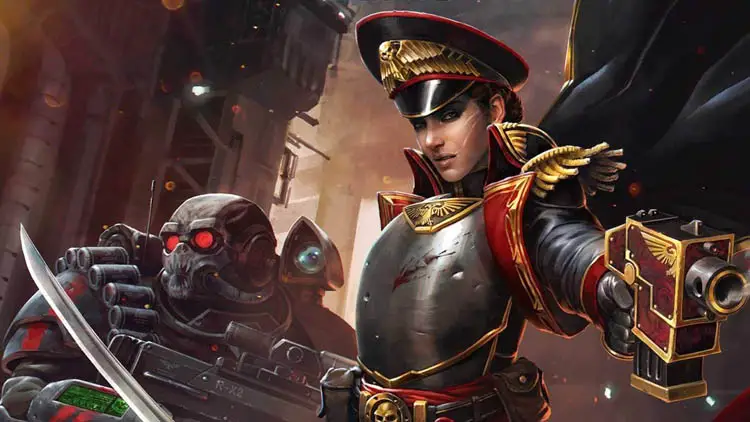
Primaris Eliminator and Commissar Severina Raine also stand out as Creatures that can be planted into dozens of other Commander decks. With more adoption, expect prices of these to stay in the $10 range, unlikely to enter into the bulk rare category.
Just like all the other Warhammer 40K decks, the Surge foil versions should fetch a decent premium over the non-foils, since those collector editions are selling for 3 times the price.
Upgradability
If you’re playing against anything outside of these Warhammer 40K decks, there are some upgrades you can consider to swap out less efficient cards. Grey Knight Paragon is a little too restrictive for Creature removal, and since it is more effective against demons, you can swap it out for any of the better white Enchantments that Exile a non-Land Permanent.
Triump of Saint Cathering‘s Miracle mechanic also doesn’t sit as well in a deck that likes attacking triggers. Instead, add in Creatures with Battle Cry, as that will buff all your other attacking Creatures +1/+0. Either Accordier Paladin and Hero of the Bladehold will slip in nicely in Forces of the Imperium.
There are also cheaper and more direct board wipes available to white, with the tried and tested Wrath of God, Fumigate or Doomskar doing a better job (and cheaper) than the few that are already in the deck.
Beginner Friendliness
Despite the higher power level of these Warhammer 40K preconstructed decks, the gameplay is pretty linear for Forces of the Imperium. The goal is to get Creatures down, use the Commander Inquisitor Greyfax for power, and then support the army using protection spells. There aren’t any counter spells here so it doesn’t complicate it for beginners.
The bigger challenge for beginners would be knowing when not to over commit to the Battlefield and cast every Creature you have in hand. Token and Creature-based decks are especially vulnerable to board wipes so a newer player will need to understand balance and not make him or herself be seen as a major threat.
Final Score
Necron Dynasties Warhammer 40K Commander
Overview
As the only mono-coloured deck in the Warhammer 40K series, it might appear that Necron Dynasties is at a disadvantage. However they have a strong focus on Graveyard recursion, bringing 1 or even multiple big cards back from to your hand or Battlefield. Their Commander Szarekh, the Silent King brings back cards with each attack, and also fills your Graveyard for other purposes.
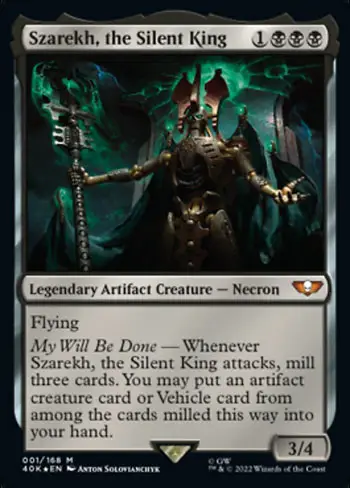
Power Level
Staying loyal to its Necron themes, Necron Dynasties cares about anything with Artifacts or the Graveyard, and there are some cards in this Warhammer 40K deck that utilise this very well. Necron Overlord can make an opponent lose life each turn just by having a bunch of Artifacts. It isn’t to all opponents, but a recurring activated ability like that can still be brutal.
The biggest handicap for Necron Dynasties is that most of their Graveyard recursion effects brings cards back to the hand and not to the Battlefield. It’s nice to get cards back, but needing to recast them again 1 by 1 really slows the pace down, not to mention the power level. There are cards like Technomancer and Out of the Tombs that do bring Creatures back to the Battlefield, but they’re either very expensive to cast or have a drawback.
Their Instants and Sorceries do pack some power. Living Death is a perfect table-turner since you will be filling your Graveyard while the opponents build their board. Living Death exchanges everything between Battlefield and Graveyard, and is an absolute bomb against the other Warhammer 40K preconstructed decks.
Value
The prerelease value of the Necron Dynasties deck is high, thanks to the secondary Commander Trazyn the Infinite, whom many say is an even better leader than Szarekh, the Silent King. If players can build a competitive deck around Trazyn, then this can become a highly sought after card.
Sceptre of Eternal Glory is the other Mana Artifact that is drawing a lot of attention, simple because it has no real drawback if you’re playing a mono colour deck. It costs 1 less than Gilded Lotus, so any mono coloured deck would love to have the Sceptre in it. With such broad usage capability, this card will likely remain a little pricey.
The fact that Necron Dynasties is only 1 colour means it does lack the Talisman Artifacts that usually are worth a couple of dollars each. In addition, dual-coloured Lands are also missing, meaning the value in that section also suffers. But there is Resurrection Orb, a new Equipment that can safely bring back any equipped Creature back alive after dying. Its ability to ‘protect’ any Commander out there makes this a hot item too.
Our own spoiler card Lychguard can also catch some value for its ability to bring back all Legendary Creatures to your hand, potentially providing great utility to the player in a long game.
Upgradability
There are a few upgrades, both cheap and not so cheap, that one can use to make Necron Dynasties more efficient. In black, the use of tutor spells can help you search for an answer to opponents’ threats. Vampiric Tutor, Demonic Tutor and Diabolic Tutor are some of the better ones, but come at a price.
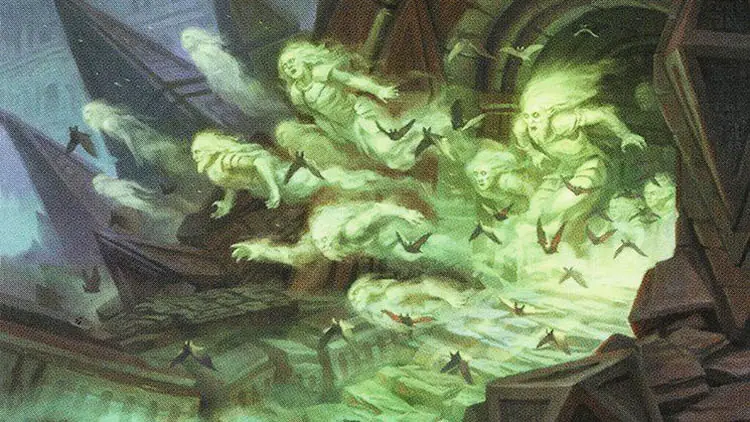
Then there are spells that just return 1 or more Creatures from the Graveyard directly onto the Battlefield. Agadeem’s Awakening, Reanimate, Blood for Bones and Return Upon of the Tide all fit nicely in Necron. Call of the Death-Dweller and Drana, the Last Bloodchief also do good work bringing back cards to the Battlefield rather than the hand.
And since Necron Dynasties is so good at Graveyard Recursion, adding a couple of good board wipes will also strengthen the deck. Blood on the Snow can also return 1 of your best Creatures (if you play Snow Lands),
Beginner Friendliness
Graveyard manipulation is usually harder to put together than the regular beat down Commander decks, but the strategy here is still fairly direct: put cards into your Graveyard, bring them back to your hand, and then cast them for more value. It does feel like a long round-about way of doing things, so the challenge for any player, beginner or otherwise, would be to find the most optimal sequence than can create the most value for them.
Just like the Ruinous Powers deck that you’ll see in a bit, Necron Dynasties would not be the 1st choice among these Warhammer 40K decks for a beginner to try out. It puts too much focus on finding the right “combo” or sequence of events to get the deck rolling, hence it’s not perfect for newcomers.
Final Score
The Ruinous Powers Warhammer 40K Commander
Overview
The Ruinous Powers unleashes the chaos army and takes advantage of the powerful Cascade mechanic to get even more monsters on the board quickly. On your turn, the more damage you deal to opponents, the more free cards you’ll get on the Battlefield, all thanks to Commander Abaddon, the Despoiler. Being in red and black (and blue), dealing both noncombat and combat damage shouldn’t be a problem.
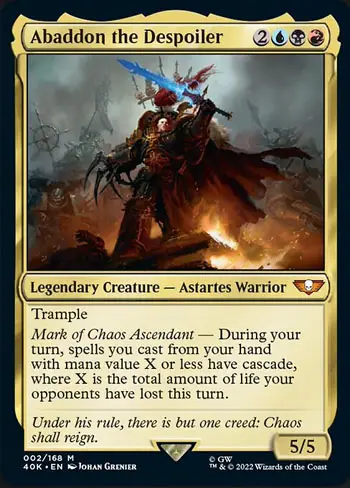
Power Level
Cascade has been 1 of the stronger mechanics in Magic history, so to have it partially inbuilt into a Commander always puts a sparkle in players’ eyes. The catch though is that you have to deal damage to the opponent before you can Cascade. Thankfully, there are plenty of cards in The Ruinous Powers that help you do that.
On the Creature front, cards such as Bloodcrusher of Thorne, Herald of Sleenash, and Chaos Terminator Lord can give your Creatures all kind of keyword buffs like Haste, Trample of Double Strike. Being able to deal that extra combat damage will help with Cascading into more spells. Then there’s the face card of the deck itself – The Ruinous Powers – that can easily make an opponent lose life just by casting his or her stuff.
The entire deck appears to have multiple lines of play, with the ability to copy Instants or Sorceries, giving other spells Cascade, combat enablers, and even a little Demon tribal. Things might not run so smoothly when you have so many archetypes trying to run together. The average casting cost is also very high, probably so that you get a bigger payoff when resolving Cascade triggers, but this can also lead to a very slow start and might even stall if you don’t draw enough Lands.
The Ruinous Powers is a potentially powerful Warhammer 40K deck, but will need some good piloting experience before you see it perform at its best.
Value
There is a nice reprint in the form of Chromatic Lantern in The Ruinous Powers, which has seen a steady growth in price. As it is an Artifact that can fit into any deck that is colour intensive, it will be a good staple card to keep that can easily hold its value.
A couple of cards new to the Warhammer decks can also carry a good price tag. Poxwalkers may look simple but has the ability to easily return from the Graveyard to the Battlefield. There are many ways to cast spells from Exile or the Graveyard, including but not limited to Cascade, which this deck is all about.
Then there’s Bloodthirster, a terrifying 6/6 Flying and Trample demon for 6 Mana, with the ability to grant extra combat steps. Such cards that give free additional steps are often in demand, though it doesn’t always equate to high prices (Port Razer and Karlach, Fury of Avernus are 2 examples that hover below US$5).
Upgradability
As the deck has so many sub-themes going on, it would be more efficient to focus on 1 or 2. Since there are already many Creatures in the deck that focus on dealing damage, 1 option is to focus on them, providing combat and non-combat damage in order to utilise Abaddon the Despoiler‘s Cascade ability. Thermo Alchemist and Spear Spewer are 2 cheap Creatures that can consistently deal damage without attacking, and you can also add Infectious Horror and Tectonic Giant that make the opponent lose life on attack.

Flame Rift is also a cheap Sorcery that can deal lots of damage to each opponent, and the same goes for Havoc Festival, though that puts you at risk of killing yourself too. Balor and Quakebringer are nice beefy Creatures that are a threat both in combat and even when not attacking.
Rakdos, Lord of Riots can serve as a reference Commander because both care about opponents losing life in order to receive a benefit.
Beginner Friendliness
While Cascade is powerful, the added clause within Abaddon the Despoiler makes things a little tricky. That’s an additional hoop that new players will have to fulfil before they can fully enjoy the deck. While the deck does rely on good old combat, which they will find fun, it also requires casting the right Creatures in order to maximise their abilities. For example, casting Exalted Flame of Tzeentch as your 1st Creature may not be wise if you have no Instants or Sorceries in the Graveyard. Having a new player keep track of multiple triggers and zones can be daunting, and this might not be the right deck for them.
Final Score
Tyranid Swarm Warhammer 40K Commander
Overview
Tyranid Swarm loves counters, and particularly focuses growing Creatures with +1/+1 counters. The Swarmlord Commander comes in as a scary 7/7 that helps you draw cards whenever any Creature with a counter dies. The swarm even comes with a new mechanic called Ravenous, where you draw a card if you pump enough Mana into them. This deck wants to grow big fast and overrun the opponents.
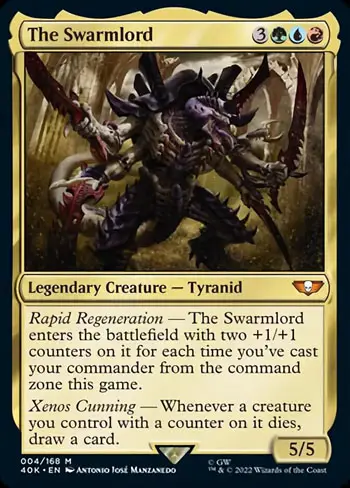
Power Level
When it comes to decks that have a ton of cards with X in their casting cost, it’s always good to look at the Mana ramp package to see if it can keep up. There’s the reliable Farseek, Cultivate, and Explore, but there is a big shortage of Mana Artifacts here. While the other Warhammer 40K decks have Talismans to help them ramp up, Tyranid Swarm comes only with the standard Sol Ring and Arcane Signet, despite it being a 3-colour deck.
With such a slow build up for Mana, casting Creatures for Ravenous will be few (since X needs to be 5 in order to trigger Ravenous). Yes, you could cast many of these Creatures as 1/1s but they won’t be doing much whether as attackers or blockers.
However, if you do live long enough to have a good number of Tyranids on the Battlefield, that’s when their synergy takes off. Many of them work like Slivers, giving each other abilities as long as they have a counter on them. Since almost all Creatures in the deck will have at least 1 counter, their swarm can easily rival the Forces of Imperium.
Value
The Tyranid Swarm Warhammer 40K deck may have the biggest Creatures, but the value of the cards are among the lowest. Their most valuable card is Toxicrene, effectively a Chromatic Lantern inbuilt onto a Creature. (Coincidentally, the Lantern is also reprinted in The Ruinous Powers).
Unfortunately, the value train stops there, with its most significant reprint being Herald’s Horn, an Uncommon that has been reprinted in recent times. Perhaps the sliver of hope comes in the new Enchantment Shadow in the Warp since it hits opponents who cast non-Creature spells. In addition, it gives a 2 Mana cost reduction for your 1st Creature spell each turn. Both of those abilities combined is huge and can be a great card to add into any deck with red and green colours.
Upgradability
For a stompy deck that relies on counters, Rhythm of the Wild is an amazing and affordable addition, being able to give any Creature Haste or a +1/+1 counter. When you have a big Creature, Haste might be more effective, and other times a +1/+1 counter will do.
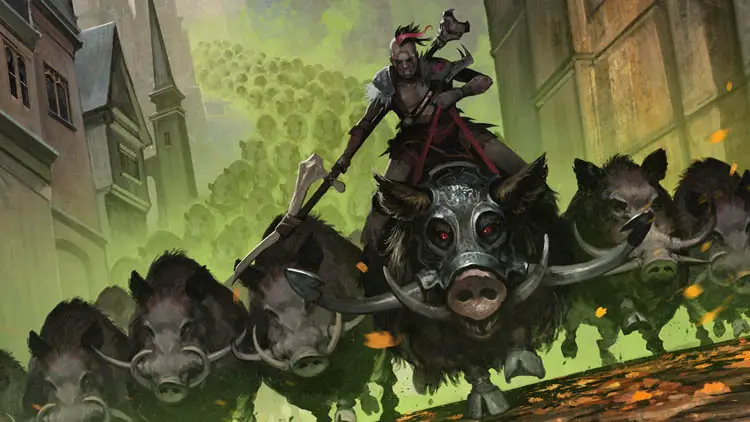
Since you can’t possibly take out Tyranids from their own deck, instead you can add in cards that boost their Power and Toughness stats. Coat of Arms will make all of them doubly huge, albeit at a hit to your wallet. Fervor or Anger are more affordable additions to give all your Creatures Haste. For beatdown decks, Haste really gets extra importance because you’re dealing significantly more damage.
Tyranid Swarm can also do better with its removal options. Hullbreach is great but you could add it more targeted removal for any Creature threats. Primal Might, Lightning Bolt, and even an Essence Scatter are good, cheap counters to anything the opponent can throw at you.
Beginner Friendliness
Spend Mana for big monsters and attack – sounds like a simple enough plan for beginners! There are no surplus requirements, and the only worry for the Tyranid Swarm player would be which Creature to cast next, since this deck does have a slow build up.
What might spoil the fun for a beginner is when they are hit by a big board wipe spell. Starting again from square 1 will not leave a good aftertaste, and unfortunately the preconstructed deck only comes with Inspiring Call to protect your Creatures.
Tyranid Swarm is almost the perfect gift to a beginner who also happens to like scary swarms of mechanical bugs. Just remember to drop a friendly note not to throw everything onto the board all at once.
Final Score
